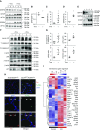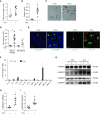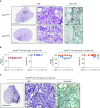Grp78 Loss in Epithelial Progenitors Reveals an Age-linked Role for Endoplasmic Reticulum Stress in Pulmonary Fibrosis
- PMID: 31738079
- PMCID: PMC6961744
- DOI: 10.1164/rccm.201902-0451OC
Grp78 Loss in Epithelial Progenitors Reveals an Age-linked Role for Endoplasmic Reticulum Stress in Pulmonary Fibrosis
Abstract
Rationale: Alveolar epithelial cell (AEC) injury and dysregulated repair are implicated in the pathogenesis of pulmonary fibrosis. Endoplasmic reticulum (ER) stress in AEC has been observed in idiopathic pulmonary fibrosis (IPF), a disease of aging.Objectives: To investigate a causal role for ER stress in the pathogenesis of pulmonary fibrosis (PF) and therapeutic potential of ER stress inhibition in PF.Methods: The role of ER stress in AEC dysfunction and fibrosis was studied in mice with tamoxifen (Tmx)-inducible deletion of ER chaperone Grp78, a key regulator of ER homeostasis, in alveolar type II (AT2) cells, progenitors of distal lung epithelium, and in IPF lung slice cultures.Measurements and Main Results:Grp78 deletion caused weight loss, mortality, lung inflammation, and spatially heterogeneous fibrosis characterized by fibroblastic foci, hyperplastic AT2 cells, and increased susceptibility of old and male mice, all features of IPF. Fibrosis was more persistent in more severely injured Grp78 knockout (KO) mice. Grp78 KO AT2 cells showed evidence of ER stress, apoptosis, senescence, impaired progenitor capacity, and activation of TGF-β (transforming growth factor-β)/SMAD signaling. Glucose-regulated protein 78 is reduced in AT2 cells from old mice and patients with IPF, and ER stress inhibitor tauroursodeoxycholic acid ameliorates ER stress and fibrosis in Grp78 KO mouse and IPF lung slice cultures.Conclusions: These results support a causal role for ER stress and resulting epithelial dysfunction in PF and suggest ER stress as a potential mechanism linking aging to IPF. Modulation of ER stress and chaperone function may offer a promising therapeutic approach for pulmonary fibrosis.
Keywords: ER stress; alveolar epithelial cell dysfunction; pulmonary fibrosis.
Figures








Comment in
-
Coming to "Grp(s)" with Senescence in the Alveolar Epithelium.Am J Respir Crit Care Med. 2020 Jan 15;201(2):134-136. doi: 10.1164/rccm.201910-2052ED. Am J Respir Crit Care Med. 2020. PMID: 31794253 Free PMC article. No abstract available.
References
-
- Selman M, Pardo A. Role of epithelial cells in idiopathic pulmonary fibrosis: from innocent targets to serial killers. Proc Am Thorac Soc. 2006;3:364–372. - PubMed
-
- Selman M, Pardo A. Revealing the pathogenic and aging-related mechanisms of the enigmatic idiopathic pulmonary fibrosis: an integral model. Am J Respir Crit Care Med. 2014;189:1161–1172. - PubMed
Publication types
MeSH terms
Substances
Grants and funding
- S10 RR022508/RR/NCRR NIH HHS/United States
- R01 CA027607/CA/NCI NIH HHS/United States
- R01 HL112638/HL/NHLBI NIH HHS/United States
- P30 DK048522/DK/NIDDK NIH HHS/United States
- R01 HL119346/HL/NHLBI NIH HHS/United States
- R35 HL135747/HL/NHLBI NIH HHS/United States
- R01 HL114959/HL/NHLBI NIH HHS/United States
- R01 HL122764/HL/NHLBI NIH HHS/United States
- R01 HL145408/HL/NHLBI NIH HHS/United States
- R01 HL126877/HL/NHLBI NIH HHS/United States
- P30 CA014089/CA/NCI NIH HHS/United States
- P30 ES013508/ES/NIEHS NIH HHS/United States
- R01 HL143059/HL/NHLBI NIH HHS/United States
- I01 BX001176/BX/BLRD VA/United States
LinkOut - more resources
Full Text Sources
Medical
Molecular Biology Databases
Research Materials
Miscellaneous

